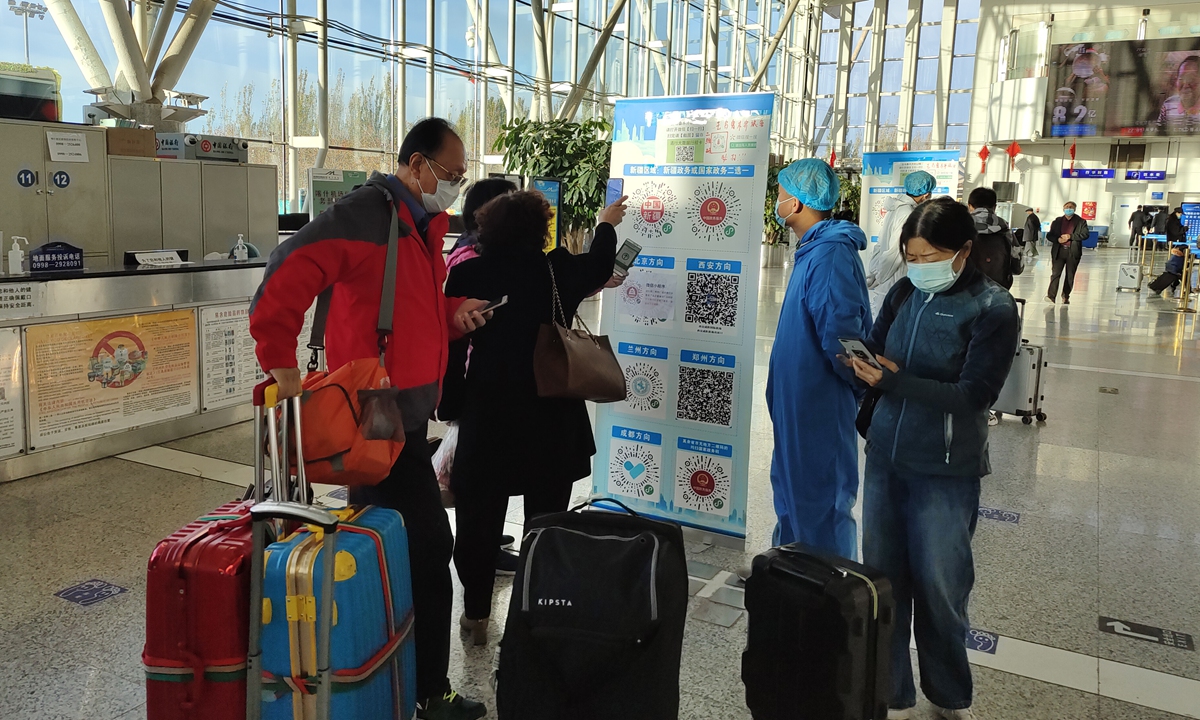Kashi kicks off 4th round of massive nucleic acid tests after discovering 116 silent virus carriers
By Liu Caiyu and Leng Shumei Source: Global Times Published: 2020/11/3 22:38:41

Travelers scan their health codes at an airport in Kashi, Xinjiang Uygur Autonomous Region on Friday. Flights has resumed to normal as the latest COVID-19 outbreak ebbs. Photo: VCG
Kashi in Northwest China's Xinjiang Autonomous Region began a fourth round of massive nucleic acid tests for COVID-19 on Wednesday to find all infected people in the region, as the county discovered 116 new asymptomatic cases on Tuesday, taking the total number of silent carriers in the prefecture to 330.
The new silent virus carriers were discovered among people already under quarantine, a local health official said at a press conference on Wednesday.
Two new confirmed cases were also discovered on Tuesday, taking the total number of confirmed infection in Kashi to 64 as of 8 pm Tuesday, according to the official.
Kizilsu Kirgiz Autonomous Prefecture in Xinjiang, which is near Kashi and had discovered 15 silent virus carriers related to the Kashi epidemic, had already started a fourth round of massive nucleic acid tests on Tuesday to find out potential cases timely and cut off the source of infection, a Kizilsu Kirgiz health official said.
"Repeat nucleic acid tests guarantee to find all infected people in the region. There are chances that people are infected but might have tested negative in previous tests as they were in the incubation period," Zhang Yuexin, a member of Xinjiang's anti-epidemic group, told the Global Times on Tuesday.
Zhang said Xinjiang would not stop giving nucleic acid tests on residents, with the fifth and sixth rounds possible, as he said 11 days had passed since the first infected patient was reported on October 24, but the incubation period of novel coronavirus infected patients is normally one to 14 days.
Xinjiang officials had also said the common incubation period is three to seven days, meaning that about 90 percent of people will test positive within three to seven days after infection, some in less than three days, and some people after more than seven days.
As infections had been found in villages of Kizilsu Kirgiz Autonomous Prefecture, a neighboring prefecture of Kashi, Zhang said the region will also test their residents to find all undiscovered infections.
Zhang revealed that unlike COVID-19 infections in Wuhan, those patients had very mild symptoms, and even no symptoms at all.
Overall, the epidemic in Kashi is under control as it is still limited to Shufu county of the city, and all new silent virus carriers were discovered among people under quarantine, Global Times has learned from sources in Kashi under the condition of anonymity.
Wang Guangfa, a respiratory expert at Peking University First Hospital, told the Global Times on Tuesday that, while conducting massive nucleic acid tests, it is equally important to conduct epidemiological surveys on discovered infections to find out the infection source, and only under this circumstance can virus transmission can be effectively curbed.
China has made significant achievements in epidemic prevention and control, but clustered outbreaks in some places reveal that there is still some weakness in anti-epidemic work, Chinese Vice Premier Sun Chunlan said Tuesday at a teleconference held by the Joint Prevention and Control Mechanism of the State Council.
Sun noted that this winter and next spring is vital period to prevent the epidemic, and local authorities should give top priority to prevent imported cases.
She called for enhancing nucleic acid tests and disinfection of imported cold-chain food to reduce infection risks.
RELATED ARTICLES:
- Kashi begins 3rd round of mass nucleic acid tests 'to track infections'
- Kashi, NW China's Xinjiang, reported 13 new virus carriers on Monday, all of whom are currently under quarantine: local official
- Kashi in Xinjiang begins third round of mass nucleic acid testing ‘to track infections in community’
Posted in: SOCIETY,CHINA FOCUS